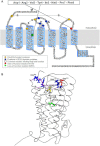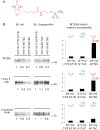Long range effect of mutations on specific conformational changes in the extracellular loop 2 of angiotensin II type 1 receptor
- PMID: 23139413
- PMCID: PMC3537051
- DOI: 10.1074/jbc.M112.392514
Long range effect of mutations on specific conformational changes in the extracellular loop 2 of angiotensin II type 1 receptor
Abstract
The topology of the second extracellular loop (ECL2) and its interaction with ligands is unique in each G protein-coupled receptor. When the orthosteric ligand pocket located in the transmembrane (TM) domain is occupied, ligand-specific conformational changes occur in the ECL2. In more than 90% of G protein-coupled receptors, ECL2 is tethered to the third TM helix via a disulfide bond. Therefore, understanding the extent to which the TM domain and ECL2 conformations are coupled is useful. To investigate this, we examined conformational changes in ECL2 of the angiotensin II type 1 receptor (AT1R) by introducing mutations in distant sites that alter the activation state equilibrium of the AT1R. Differential accessibility of reporter cysteines introduced at four conformation-sensitive sites in ECL2 of these mutants was measured. Binding of the agonist angiotensin II (AngII) and inverse agonist losartan in wild-type AT1R changed the accessibility of reporter cysteines, and the pattern was consistent with ligand-specific "lid" conformations of ECL2. Without agonist stimulation, the ECL2 in the gain of function mutant N111G assumed a lid conformation similar to AngII-bound wild-type AT1R. In the presence of inverse agonists, the conformation of ECL2 in the N111G mutant was similar to the inactive state of wild-type AT1R. In contrast, AngII did not induce a lid conformation in ECL2 in the loss of function D281A mutant, which is consistent with the reduced AngII binding affinity in this mutant. However, a lid conformation was induced by [Sar(1),Gln(2),Ile(8)] AngII, a specific analog that binds to the D281A mutant with better affinity than AngII. These results provide evidence for the emerging paradigm of domain coupling facilitated by long range interactions at distant sites on the same receptor.
Figures







Similar articles
-
Ligand-specific conformation of extracellular loop-2 in the angiotensin II type 1 receptor.J Biol Chem. 2010 May 21;285(21):16341-50. doi: 10.1074/jbc.M109.094870. Epub 2010 Mar 18. J Biol Chem. 2010. PMID: 20299456 Free PMC article.
-
Role of the transmembrane domain 4/extracellular loop 2 junction of the human gonadotropin-releasing hormone receptor in ligand binding and receptor conformational selection.J Biol Chem. 2011 Oct 7;286(40):34617-26. doi: 10.1074/jbc.M111.240341. Epub 2011 Aug 10. J Biol Chem. 2011. PMID: 21832286 Free PMC article.
-
The second transmembrane domain of the human type 1 angiotensin II receptor participates in the formation of the ligand binding pocket and undergoes integral pivoting movement during the process of receptor activation.J Biol Chem. 2009 May 1;284(18):11922-9. doi: 10.1074/jbc.M808113200. Epub 2009 Mar 9. J Biol Chem. 2009. PMID: 19276075 Free PMC article.
-
Understanding the common themes and diverse roles of the second extracellular loop (ECL2) of the GPCR super-family.Mol Cell Endocrinol. 2017 Jul 5;449:3-11. doi: 10.1016/j.mce.2016.11.023. Epub 2016 Nov 27. Mol Cell Endocrinol. 2017. PMID: 27899324 Review.
-
Current topics in angiotensin II type 1 receptor research: Focus on inverse agonism, receptor dimerization and biased agonism.Pharmacol Res. 2017 Sep;123:40-50. doi: 10.1016/j.phrs.2017.06.013. Epub 2017 Jun 23. Pharmacol Res. 2017. PMID: 28648738 Free PMC article. Review.
Cited by
-
Electronic sculpting of ligand-GPCR subtype selectivity: the case of angiotensin II.ACS Chem Biol. 2014 Jul 18;9(7):1420-5. doi: 10.1021/cb500063y. Epub 2014 May 14. ACS Chem Biol. 2014. PMID: 24787922 Free PMC article.
-
Mechanism of Hormone Peptide Activation of a GPCR: Angiotensin II Activated State of AT1R Initiated by van der Waals Attraction.J Chem Inf Model. 2019 Jan 28;59(1):373-385. doi: 10.1021/acs.jcim.8b00583. Epub 2019 Jan 16. J Chem Inf Model. 2019. PMID: 30608150 Free PMC article.
-
Molecular Effects of Auto-Antibodies on Angiotensin II Type 1 Receptor Signaling and Cell Proliferation.Int J Mol Sci. 2022 Apr 2;23(7):3984. doi: 10.3390/ijms23073984. Int J Mol Sci. 2022. PMID: 35409344 Free PMC article.
-
The non-biphenyl-tetrazole angiotensin AT1 receptor antagonist eprosartan is a unique and robust inverse agonist of the active state of the AT1 receptor.Br J Pharmacol. 2018 Jun;175(12):2454-2469. doi: 10.1111/bph.14213. Epub 2018 May 6. Br J Pharmacol. 2018. PMID: 29570771 Free PMC article.
-
AT1-receptor response to non-saturating Ang-II concentrations is amplified by calcium channel blockers.BMC Cardiovasc Disord. 2017 May 17;17(1):126. doi: 10.1186/s12872-017-0562-x. BMC Cardiovasc Disord. 2017. PMID: 28514967 Free PMC article.
References
-
- Lagerström M. C., Schiöth H. B. (2008) Structural diversity of G protein-coupled receptors and significance for drug discovery. Nat. Rev. Drug Discov. 7, 339–357 - PubMed
-
- Vaidehi N., Kenakin T. (2010) The role of conformational ensembles of seven transmembrane receptors in functional selectivity. Curr. Opin. Pharmacol. 10, 775–781 - PubMed
Publication types
MeSH terms
Substances
Grants and funding
LinkOut - more resources
Full Text Sources
Other Literature Sources
Molecular Biology Databases
Miscellaneous

